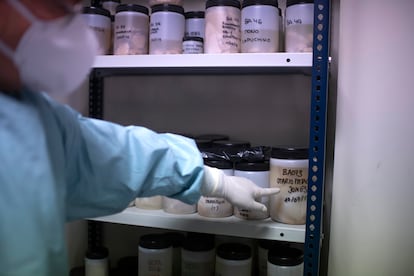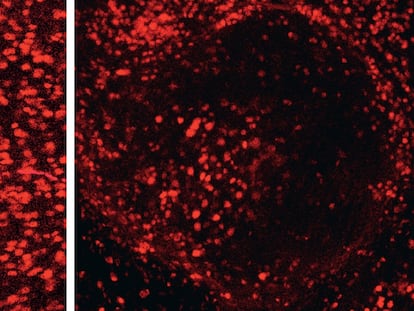Researchers identify the first suspected cases of Alzheimer’s transmission
Five people under the age of 55 have dementia after receiving growth hormones obtained from cadavers. Researchers emphasize that the disease is not contagious

It was an unintentional experiment with tragic results. Thousands of short people around the world received growth hormones extracted from the pituitary gland of cadavers. The treatment was discontinued around 1985, when it was discovered that these intramuscular injections could transmit the prions that cause the deadly Creutzfeldt-Jakob disease, which is similar to mad cow disease. Now, a new study reveals another undesirable effect of those therapies. A University College London research team believes that those treatments with pituitary hormones — a pea-sized gland at the base of the brain — transmitted Alzheimer’s disease to five people in the United Kingdom. These would be the first known cases of transmission of the disease.
Some 55 million people worldwide suffer from dementia, which is linked to Alzheimer’s in most cases. The tragic and unintentional experiment could shed light on the mysterious mechanisms of the disease, which still lacks an effective treatment. It is common to find abnormal accumulations of two proteins — beta-amyloid and tau — in the brains of deceased patients. Led by neurologist John Collinge, the same research team warned in 2015 that they had detected suspicious beta-amyloid plaque in the brains of six people who died of Creutzfeldt-Jakob disease after receiving growth hormones. In 2018, they detected amyloid beta in batches of the hormone stored for decades and proved that these proteins caused dementia in laboratory mice.
The Collinge research team is convinced that it has found the first five known cases of accidental transmission of Alzheimer’s disease. All those affected received growth hormones from cadavers, often for years, and began to show symptoms of dementia when they were between the ages of 38 and 55 years old, despite lacking the genetic variants present in other early cases. The finding was published on Monday in the scientific journal Nature Medicine.
In 2015, early indications triggered worldwide alarm as a result of some erroneous headlines, especially in the tabloid press. The British tabloid Daily Mirror proclaimed on its front page: “You can catch Alzheimer’s.” The Collinge team emphasizes that cadaver hormone treatments were discontinued decades ago and that “there is no evidence that beta amyloids can be transmitted in other contexts, for example, during activities of daily living or when providing routine care.”
However, the authors call for a review of the measures in place to prevent the accidental transmission of Alzheimer’s disease during invasive surgery. “The instruments used in neurosurgery are the main concern; we must ensure that they are decontaminated,” Collinge told EL PAÍS.
An international study conducted just over a decade ago found 226 cases of Creutzfeldt-Jakob disease caused by growth hormone treatments from cadavers. Epidemiologist Fernando García López says that a hundred cases have been detected in France. Garcia Lopez, of Spain’s National Epidemiology Center, explains that there have been eight cases of Creutzfeldt-Jakob disease caused by implants of dura mater — one of the membranes that protect the brain — after brain tumor operations in Spain. Since 1987, the epidemiologist explains, the dura mater obtained from cadavers has been treated with lye and the problem was eliminated.
Almost 2,000 people in the United Kingdom received growth hormones obtained from cadavers between 1959 and 1985. To date, some 80 cases of Creutzfeldt-Jakob disease caused by these treatments have been observed. The expected outcome, the researchers argue, would be to find more cases of Alzheimer’s disease in this group of patients. Epidemiologist Fernando García López notes that Spain has had a surveillance system in place since 1995, which analyzes whether patients with Creutzfeldt-Jakob disease received growth hormones decades ago. “Why has France had 119 cases and [Spain] has had none? It’s a mystery,” he says.
In 1996, John Collinge’s lab showed that the new variant Creutzfeldt-Jakob disease stemmed from the same strain of prions — abnormal transmissible proteins — that caused mad cow disease. The British neurologist believes that there are lessons from that prion disease that can also be applied to Alzheimer’s disease. Collinge and his colleagues hypothesize that beta-amyloids do not have a single profile, but are “a cloud of diverse species,” as is the case with prions. Ignoring that heterogeneity could lead to the emergence of resistance to early Alzheimer’s drugs.
Neurologist Pascual Sánchez Juan is categorical. “Alzheimer’s disease is not contagious. Caring for patients at home or in nursing homes does not imply any risk,” he explains. Sánchez Juan is the scientific director of the Foundation Center for the Investigation of Neurological Diseases in Madrid, Spain. “If we find out the specific strain, we will be able to better direct each patient’s treatment, but we have not yet been able to correlate this diversity of beta-amyloid plaque with the different clinical subtypes of Alzheimer’s disease,” he laments. The expert, who belongs to the Spanish Society of Neurology, is optimistic: “Alzheimer’s probably stems from many causes, but there are many mechanisms that we do not know. This new study is an unrepeatable scientific experiment. They unintentionally injected the pathology into the patients. Now they will be able to clarify things that would be impossible otherwise.”
Sign up for our weekly newsletter to get more English-language news coverage from EL PAÍS USA Edition
Tu suscripción se está usando en otro dispositivo
¿Quieres añadir otro usuario a tu suscripción?
Si continúas leyendo en este dispositivo, no se podrá leer en el otro.
FlechaTu suscripción se está usando en otro dispositivo y solo puedes acceder a EL PAÍS desde un dispositivo a la vez.
Si quieres compartir tu cuenta, cambia tu suscripción a la modalidad Premium, así podrás añadir otro usuario. Cada uno accederá con su propia cuenta de email, lo que os permitirá personalizar vuestra experiencia en EL PAÍS.
¿Tienes una suscripción de empresa? Accede aquí para contratar más cuentas.
En el caso de no saber quién está usando tu cuenta, te recomendamos cambiar tu contraseña aquí.
Si decides continuar compartiendo tu cuenta, este mensaje se mostrará en tu dispositivo y en el de la otra persona que está usando tu cuenta de forma indefinida, afectando a tu experiencia de lectura. Puedes consultar aquí los términos y condiciones de la suscripción digital.
More information
Archived In
Últimas noticias
Most viewed
- Sinaloa Cartel war is taking its toll on Los Chapitos
- Oona Chaplin: ‘I told James Cameron that I was living in a treehouse and starting a permaculture project with a friend’
- Reinhard Genzel, Nobel laureate in physics: ‘One-minute videos will never give you the truth’
- Why the price of coffee has skyrocketed: from Brazilian plantations to specialty coffee houses
- Silver prices are going crazy: This is what’s fueling the rally











































